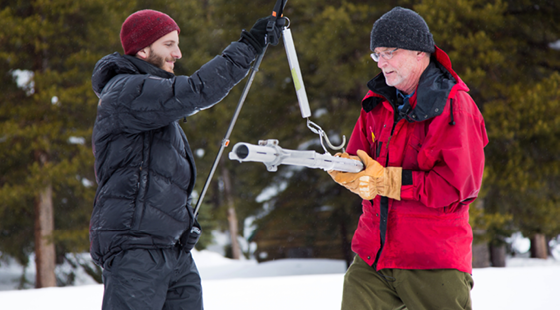This month’s snow survey showed a huge increase in the snowpack from January, but state water officials are reminding Californians that precipitation could stop suddenly.
Of the last 10 water years, eight have been dry, one wet and one average, according to state climatologist Mike Anderson.

The Department of Water Resources (DWR) manual snow survey on February 2 at Phillips Station in the Sierra Nevada range found a snow water equivalence of 28.1 inches, a significant increase since the January 3 survey, when just 6 inches was found there.
Snow water equivalence is the depth of water that theoretically would result if the entire snowpack melted instantaneously, according to DWR. That measurement is more important than depth in evaluating the status of the snowpack. On average, the snowpack supplies about 30% of California’s water needs as it melts in the spring and early summer.
The first months of the 2017 water year (October 1 to January 26) have been exceptionally wet in California due to atmospheric river storms and rainfall from lesser storms that drenched the state. All three regions DWR monitors continuously for rainfall had recorded more by January 23 than their annual averages for the entire water year, which runs from October 1 through September 30.
More telling than a survey at a single location are DWR’s electronic readings on February 2 from 101 stations scattered throughout the Sierra Nevada. Statewide, the snowpack holds 31 inches of water equivalent, or 173% of the February 2 average (18.1 inches). On January 1 before a series of January storms, the snow water equivalent of the statewide snowpack was 6.5 inches, just 64% of the New Year’s Day average.
“We’ve had a tremendous increase in rainfall and snowfall so far this season,” said Doug Carlson, a spokesman for the state Department of Water Resources. “It’s way up there compared to a month ago.”
Caution
According to The Mercury News, state officials are still urging caution, however, and say that Governor Edmund G. Brown Jr. isn’t likely to decide whether to amend or rescind the state’s emergency drought declaration (from January 2014) until April, when the full winter season is over. After his administration eased state drought regulations last summer, most cities dropped surcharges, fines and lawn watering limits.
“We’re hoping people don’t get carried away by these figures and fail to recognize how quickly things can change,” Carlson said. “They can change on a dime. We are still encouraging people to be water conscious and consider water conservation to be a California way of life.”
Measurements indicate the water content of the northern Sierra snowpack is 26 inches, 144% of the multi-decade average for the date. The central and southern Sierra readings are 32 inches (173% of average) and 32 inches (200% of average) respectively.
Regional Readings
• The average annual precipitation at the eight-station Northern California index is 50 inches; that total was surpassed on January 20, 112 days into the 2017 water year. More rain fell in the region from October through January of the 1997 water year (58.22 inches) than during the same period this water year (53.2 inches).
• The San Joaquin Basin rainfall total on February 2 was 204% of average for the date.
• Tulare Basin rainfall was 207% of average for the date.
Shasta Lake, California’s largest surface reservoir, held 114% of its historical average on February 2. A year ago, Shasta’s storage was just 78% of its February 2 average. Similarly, Lake Oroville, the State Water Project’s largest reservoir, held 121% of its historical average on February 2 compared to just 68% one year ago.
Although this year, so far, is exceptionally wet, storms can cease, the DWR comments. For example, after the previous drought declaration was ended in March 2011—and the arrival of some storms in November and December 2012—severe drought returned, leading to the driest four-year period (and some of the warmest years) in California history.
Water Savings
The State Water Resources Control Board announced on January 4 that urban Californians’ monthly water conservation was 18.8% in November, a decrease from 19% in October and below the 20.2% savings in November 2015, when state-mandated conservation targets were in place. The State Water Board stressed the need for continued conservation given that Central and Southern California remain in drought conditions and the statewide snowpack is below average despite recent storms.
The cumulative statewide savings from June 2015 through November 2016 remains at 22.6%, compared with the same months in 2013. Since June 2015, 2.35 million acre-feet of water has been saved — enough water to supply more than 11 million people, or more than one-quarter of the state’s population, for a year.
Drought Regulations
The State Water Board decided on February 8 to leave the emergency drought regulations in place.
A number of water agencies, including some in Southern California, had asked the State Water Board to let the emergency restrictions expire at the end of the month, arguing that continuing the emergency drought rules is difficult to justify to the public when reservoirs are fuller than historical averages.
Other Southern California water agencies, however, agreed with the State Water Board staff in urging the emergency restrictions be continued.
The water board will revisit the question of whether to continue the drought restrictions in May at the end of the wet season.

